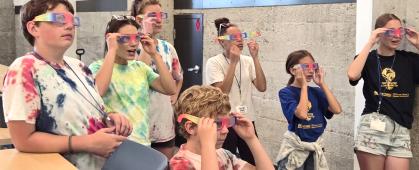
Women in STEM feature: Morgan Hasenmyer
Where are you from?Mansfield, TXWhat do you like to do for fun?Play volleyball, hike, read and sewCan you describe your research?

Fire Science Field Day: Educators Explore Wildfire Mitigation in Montana
As part of the Montana Federation of Public Employees 2025 Educator Conference, SMART FIRES hosted a Fire Science Field Day in Missoula on October 17. The full-day event welcomed 11 educators from across the state to explore how locally relevant fire science can be integrated into K–12 classrooms.

Future teachers explore citizen science at MSU
Pre-service teachers (future science teachers) from EDM 403 and EDM 415 (Science Methods) at MSU helped pilot-test Temtop air quality instruments as part of their classes’ unit on citizen science. The instruments will become part of the SMART FIRES Instrument Lending Library being developed for Montana teachers.

SMART FIRES Year 3 Annual Meeting: Building a Smarter Future for Montana’s Fire Landscape
The Montana NSF EPSCoR SMART FIRES project convened its Year 3 ‘All Hands Meeting’ (AHM2025) on September 8–9, 2025 at Montana State University (MSU) in Bozeman, bringing together researchers, students, partners, and advisors from across the state and beyond to share progress, spark new collaborations, and deepen interdisciplinary connections.

Women in STEM feature: Dr. Anh Nguyen
Where are you from?I’m originally from Ho Chi Minh City, Vietnam.What do you like to do for fun?I love cooking Vietnamese foods and playing badminton when I’m indoors. Outdoors, I enjoy exploring new hiking trails, checking out new places, lakes, and camping spots, and visiting national parks.

Montana EPSCoR Supports Inclusive Learning at MSU Summer Camp
Montana NSF EPSCoR proudly continued its sponsorship of Montana State University’s Inclusive Community Camp (ICC), now in its sixth summer.

Interview with Dr. Jacob Downs: New UM Computer Science Hire
Dr. Jacob Downs is a new associate professor in computer science at the University of Montana. With a background in machine learning and numerical modeling regarding environmental systems he is excited to engage with SMART FIRES researchers and inspire the next generation of computer scientists. How did you get into STEM?

Women in STEM Feature: Mary Farina
Where are you from?I am from Rhode Island, originally up there, and I lived in Massachusetts for about 10 years before moving to Montana. What do you like to do for fun?I like to get outside and hike. I am learning guitar and Spanish. Working in the sciences, I think it's very helpful to keep your brain healthy and try to find a balance. That actually can help you do your scientific analysis work. What do you research?

Celebrating 75 Years of the NSF: Plant and Pollinator Palooza
May 10th was the 75th anniversary of the National Science Foundation. In conjunction with Montana NSF EPSCoR, the Science Math Resource Center at Montana State University hosted a Plant and Pollinator Palooza highlighting local citizen science projects.

SMART FIRES Undergraduate Joseph Knudsen Highlighted by University of Montana
The UM News service has written a piece highlighting SMART FIRES undergraduate Joseph Knudsen. Joseph works with Dr. Lu Hu in the Smart Optical Sensor thrust. Get to know Joseph, his career goals, and his work on the High Quality Atmospheric Readings and Telemetry Station by reading the article.